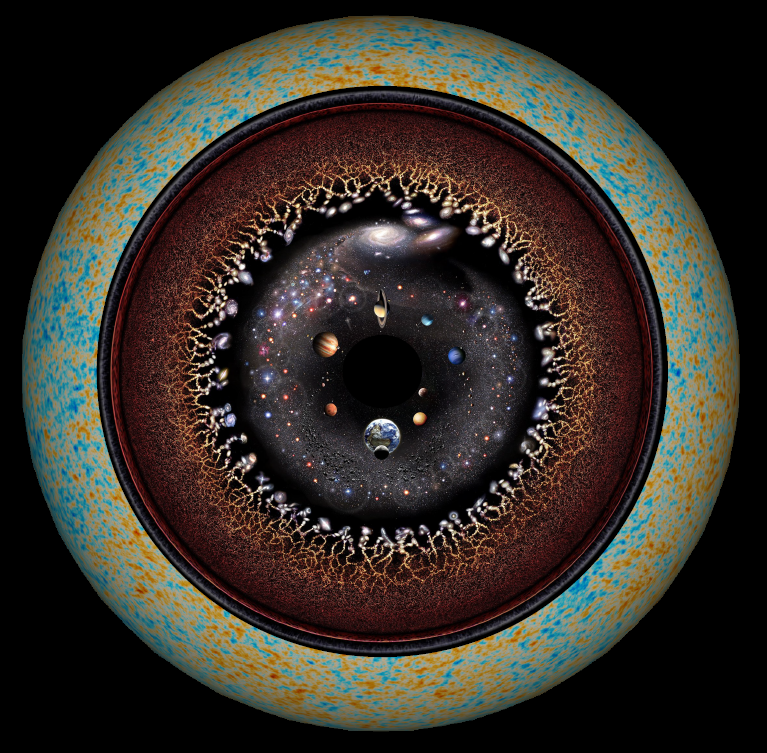Science
The Science Questions That Drive the CMB-HD Project
Science Questions that Drive CMB-HD

What is the distribution of matter on small scales?

What are the particle properties of dark matter?

How did gas evolve in and around dark matter halos?

How did galaxies form?

Do new light particles exist that were in equilibrium with known particles in the early Universe?

Do axion-like particles exist?

Do primordial gravitational waves exist from an epoch of inflation?

If inflation happened, did it arise from multiple or a single new field?

What is the census of bodies in the outer Solar System?

Do Oort clouds exist around other stars?

What is the physics behind the various bright transient phenomena in the sky?

What are the population distributions of star-forming galaxies and active galactic nuclei?

Was the early Universe magnetized and did that provide the seeds of galactic magnetic fields?
Specific CMB-HD Science Objectives
1. Measure the small-scale matter power spectrum from weak gravitational lensing using the CMB as a backlight; with this...
1. Measure the small-scale matter power spectrum from weak gravitational lensing using the CMB as a backlight; with this, CMB-HD aims to distinguish between a matter power spectrum predicted by models that can explain observational puzzles of small-scale structure, and that predicted by vanilla cold dark matter (CDM), with a significance of at least 8σ. This measurement would be a clean measurement of the matter power spectrum on these scales, free of the use of baryonic tracers. It would greatly limit the allowed models of dark matter and baryonic physics, shedding light on dark-matter particle properties and galaxy evolution.
2. Measure the number of light particle species that were in thermal equilibrium with the known standard-model particles at...
2. Measure the number of light particle species that were in thermal equilibrium with the known standard-model particles at any time in the early Universe, i.e. Neff, with a 1σ uncertainty of σ(Neff) = 0.014. This would cross the critical threshold of 0.027, which is the amount that any new particle species must change Neff away from its Standard Model value of 3.04. Such a measurement would rule out or find evidence for new light thermal particles with at least 95% confidence level. This is particularly important because many dark matter models predict new light thermal particles, and recent short-baseline neutrino experiments have found puzzling results possibly suggesting new neutrino species.
3. Measure the primordial non-Gaussian fluctuations in the CMB, characterized by the parameter fNL, with an uncertainty of...
3. Measure the primordial non-Gaussian fluctuations in the CMB, characterized by the parameter fNL, with an uncertainty of σ(fNL) = 0.26, by combining the kSZ signal from CMB-HD with an overlapping galaxy survey such as LSST. Reaching a target of σ(fNL) < 1 would rule out a wide class of multi-field inflation models, shedding light on how inflation happened. This cross-correlation could also resolve the physical nature of several statistical anomalies in the primary CMB that may suggest new physics during inflation and provide constraints on the state of the Universe before inflation.
4. Remove 90% of the CMB B-mode fluctuations from gravitational lensing over half the sky, leaving only 10% remaining...
4. Remove 90% of the CMB B-mode fluctuations from gravitational lensing over half the sky, leaving only 10% remaining, i.e. achieve Alens = 0.1. This would enable other CMB experiments with small-aperture telescopes, such as CMB-S4, to achieve their target measurement of the amplitude of primordial gravitational waves, given by the parameter r, with an uncertainty of σ(r) < 5×10−4; CMB-HD would serve as the large aperture telescope required for B-mode “de-lensing”.
5. Separately measure the density, pressure, temperature, and velocity profiles of intrahalo gas, as a function of halo mass and...
5. Separately measure the density, pressure, temperature, and velocity profiles of intrahalo gas, as a function of halo mass and redshift, by combining CMB-HD’s tSZ and kSZ measurements. This would probe thermal, non-thermal, and non-equilibrium processes associated with cosmic accretion, merger dynamics, and energy feedback from stars and supermassive black holes and their impact on the gas.
6. Probe the gas physics in and around halos out to z ∼ 2 and with masses below 1012 M⊙, by stacking low-mass and...
6. Probe the gas physics in and around halos out to z ∼ 2 and with masses below 1012 M⊙, by stacking low-mass and high-redshift halos detected via the tSZ effect in the CMB-HD survey. The circumgalactic reservoirs of 1012 M⊙ (Milky-Way-mass) halos are predicted by multiple simulations, such as EAGLE and Illustris-TNG, to be intimately linked to the appearance of, and activity within, the galaxy. These and other simulations find that galactic star-formation rates, colors, and morphologies are inextricably linked not only to the mass in the circumgalactic medium but also to the location of baryons ejected beyond R200,c, which can be uniquely constrained by CMB-HD. Thus, the science gain of such measurements is a more complete understanding of galaxy cluster astrophysics, the physics of the intergalactic and circumgalactic medium, and galaxy evolution.
7. Detect dwarf-size planets in our Solar System hundreds of AU from the Sun, and Earth-sized planets thousands of...
7. Detect dwarf-size planets in our Solar System hundreds of AU from the Sun, and Earth-sized planets thousands of AU from the Sun. In combination with optical measurements, CMB-HD would allow large population studies of the sizes and albedos of these objects.
8. Detect exo-Oort clouds around other stars, opening a new window on planetary studies. Advance the study of debris disks around large stellar populations.
9. Survey half the sky with roughly daily cadence, and make daily maps with a noise sensitivity of 1 mJy at 150 GHz...
9. Survey half the sky with roughly daily cadence, and make daily maps with a noise sensitivity of 1 mJy at 150 GHz, in order to study the time variable and transient millimeter-wave sky. The intent of the CMB-HD project is to provide to the astronomy community weekly maps of the CMB-HD survey footprint, filtered to keep only small scales, and with a reference map subtracted to make variability apparent.
10. Obtain a catalog of high-redshift dusty star-forming galaxies and active galactic nuclei down to a flux limit of 0.5 mJy at 150 GHz...
10. Obtain a catalog of high-redshift dusty star-forming galaxies and active galactic nuclei down to a flux limit of 0.5 mJy at 150 GHz. Such a catalog would enable the study of the population distributions of these galaxies.
11. Probe the existence of primordial magnetic fields (PMFs) to find evidence for magnetogenesis in the early Universe...
11. Probe the existence of primordial magnetic fields (PMFs) to find evidence for magnetogenesis in the early Universe and reveal the seeds of observed galactic magnetic fields. CMB-HD will have the high resolution and sensitivity needed to probe the magnetic vortical vector mode—the high-l feature of PMFs that survives Silk damping. CMB-HD’s data on magnetic signatures in non-Gaussianity, improved measurement of B-modes and Faraday rotation, and measurement of the small-scale matter power spectrum would improve magnetic field limits by an order of magnitude. CMB-HD could tighten this bound well below the 1 nG threshold, which would rule out a purely primordial origin of galactic magnetic fields.
12. Constrain or discover axion-like particles by observing the resonant conversion of CMB photons into axions in the magnetic...
12. Constrain or discover axion-like particles by observing the resonant conversion of CMB photons into axions in the magnetic fields of galaxy clusters. Nearly massless pseudoscalar bosons, often generically called axions, appear in many extensions of the standard model. A detection would have major implications both for particle physics and for cosmology, not least because axions are also a well-motivated dark matter candidate. CMB-HD has the opportunity to provide a world-leading probe of the electromagnetic interaction between axions and photons using the resonant conversion of CMB photons and axions in the magnetic field of galaxy clusters, independently of whether axions constitute the dark matter. CMB-HD would explore the mass range of 10−14 eV < ma < 2 × 10−12 eV and improve the constraint on the axion coupling constant by over 2 orders of magnitude over current particle physics constraints to gaγ < 0.1 × 10−12 GeV−1. These ranges are unexplored to date and complementary with other cosmological searches for the imprints of axion-like particles on the cosmic density field.
Reference
Sehgal, N et al, CMB-HD:
Astro2020 RFI Response, Feb 2020, https://arxiv.org/abs/2002.12714

